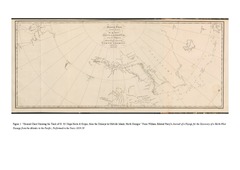| dc.contributor.advisor | Schimanski, Johan | |
| dc.contributor.author | Kjeldaas, Sigfrid | |
| dc.date.accessioned | 2017-11-07T09:11:42Z | |
| dc.date.available | 2017-11-07T09:11:42Z | |
| dc.date.issued | 2017-11-10 | |
| dc.description.abstract | This dissertation investigates how Barry Lopez’s Arctic Dreams: Imagination and Desire in a Northern Landscape (1986) engages in a search for a more inclusive, ethical and non-utilitarian understanding of the natural world that may lead to a new and more cautious approach to arctic animals and landscapes. As defined by Don Scheese and Timo Maran, nature writing is uniquely suited to accommodate the heterogeneity of perspectives needed to establish such an understanding. Using Mary Louise Pratt’s concept of the contact zone, I examine how Arctic Dreams functions as a literary contact zone that occasions the meeting and interaction of perspectives from modern fields of science (including field biology, Umweltlehre, and quantum physics), Inuit ontologies, and Western aesthetics. In their zone of interaction, these perspectives challenge modern Western conceptions of the natural world: of landscape and space, animals and subjecthood. Through the inclusion of such a heterogeneous multitude of perspectives, Arctic Dreams engenders an image of the North American Arctic as a vibrant and lively place of human and animal subjects and societies: as a natural-cultural contact zone and a civilization.
Taking as its premise nature writing’s origin in nineteenth-century scientific and Romantic explorations of the natural world, this dissertation also describes what happens in the contact zone between scientific and aesthetic representations of the Arctic. To do justice to the context and history of these representations, I study the text’s relationship to the tradition of arctic exploration literature and to the tradition of literary Romanticism. This reveals how Lopez in Arctic Dreams applies and reworks the aesthetics of Romanticism, including the aesthetics of the natural (or arctic) sublime. Written at a point in time in which the Arctic was no longer a region beyond the known world and the reach of modernity, Lopez’s text reveals how scientific knowledge can evoke a new and ecological form of sublimity in meeting with the natural world. The arctic sublime becomes in Arctic Dreams not an expression of the human relationship with a transcendental God, but with the materiality of the natural world in all its otherness. | en_US |
| dc.description.doctoraltype | ph.d. | en_US |
| dc.description.popularabstract | This dissertation investigates Barry Lopez’s Arctic Dreams: Imagination and Desire in a Northern Landscape (1986) from an arctic perspective, and with a view to how it presents arctic landscapes and animals. It reads Lopez’s text in the traditions of North American nature writing and arctic exploration literature, and looks at how scientific and Romantic ideas and representations of the region meet in this text. My claim is that if we read Arctic Dreams in terms of a contact zone in which these perspectives engage in creative dialogue with each other and with Inuit perspectives on the natural environment, new aspects of this classic text emerge, along with new visions of the Arctic. Lopez’s Arctic becomes a lively and social space in which animals and humans coexist within all-encompassing relationship networks that bridge the worlds of nature and culture. In Arctic Dreams Lopez combines scientific information with Romantic aesthetics in order to evoke this more social and material understanding of arctic landscapes, while at the same time exposing to us the values and limitations of these two different forms of representation. As if in consequence of these reflections, Lopez’s text reworks the nineteenth-century Romantic aesthetic of the arctic natural sublime into a twentieth-century ecological sublime. This reworking reflects the environmental thrust of Arctic Dreams, which throughout its sustained reflections on the Arctic challenges Western culture’s instrumental and reductive perspectives on animals in particular and the natural world in general. | en_US |
| dc.identifier.uri | https://hdl.handle.net/10037/11704 | |
| dc.language.iso | eng | en_US |
| dc.publisher | UiT Norges arktiske universitet | en_US |
| dc.publisher | UiT The Arctic University of Norway | en_US |
| dc.rights.accessRights | openAccess | en_US |
| dc.rights.holder | Copyright 2017 The Author(s) | |
| dc.rights.uri | https://creativecommons.org/licenses/by-nc-sa/3.0 | en_US |
| dc.rights | Attribution-NonCommercial-ShareAlike 3.0 Unported (CC BY-NC-SA 3.0) | en_US |
| dc.subject | VDP::Humaniora: 000::Litteraturvitenskapelige fag: 040::Engelsk litteratur: 043 | en_US |
| dc.subject | VDP::Humanities: 000::Literary disciplines: 040::English literature: 043 | en_US |
| dc.subject | nature writing | en_US |
| dc.subject | ecocriticism | en_US |
| dc.subject | animals | en_US |
| dc.subject | landscape | en_US |
| dc.subject | the sublime | en_US |
| dc.subject | the arctic | en_US |
| dc.title | Nature Writing as Contact Zone: Western and Inuit Perspectives on Landscape and Animals in Barry Lopez's Arctic Dreams | en_US |
| dc.type | Doctoral thesis | en_US |
| dc.type | Doktorgradsavhandling | en_US |


 English
English norsk
norsk


